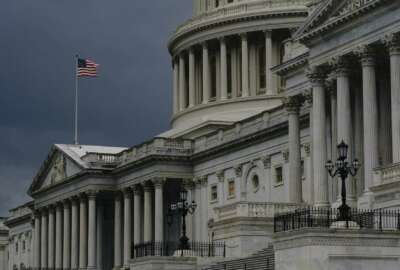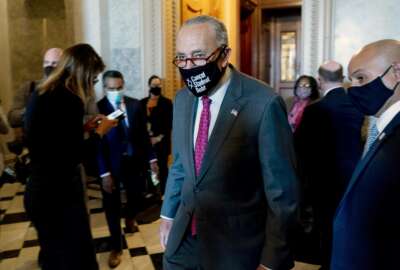What another continuing resolution could mean for contractors in 2022
Congress is focused this week on long-term infrastructure spending. But the clock is quickly winding down on the end of the fiscal year deadline to keep the basic...
Best listening experience is on Chrome, Firefox or Safari. Subscribe to Federal Drive’s daily audio interviews on Apple Podcasts or PodcastOne.
Congress is focused this week on long-term infrastructure spending. But the clock is quickly winding down on the end of the fiscal year deadline to keep the basic functions of government working. We’re almost certain to start fiscal 2022, under a continuing resolution. How long it lasts and whether we might face a government shutdown later this year are bigger questions. Larry Allen, the president of Allen Federal Business Partners joined Federal Drive with Tom Temin to talk about it some more.
Interview transcript:
Jared Serbu: All right, Larry, it’s been a while but we do look like we have a combination of debt ceiling crisis and government shutdown possibility converging again, which we haven’t had together in a while. Why do you think these are real possibilities in real threats this year?
Larry Allen: Jared, I think this is a real threat this year because we have a very contentious Congress, one where each house has very narrow majorities. We’ve also just had the Senate pass a large spending bill, the House is going to take that up very shortly, there are going to be conservative – fiscal conservatives who want to have a say in whether or not that money actually gets allocated. We have this triple witching hour, that’s converging. All of the spending bills are up for passage, some have been passed, we have the end of the fiscal year coming up, which will need in all likelihood, a continuing resolution and not an appropriations bill. And then in October and a yet undefined time, the Congress is going to have to vote to increase the debt ceiling. On paper anyway, Jared, that’s a vote that requires 60 votes in the Senate. Those votes really just aren’t there right now. That’s why I think that this is a time when we could really see a government shutdown sometime right after the start of the fiscal year. It’s unrealistic to think that we’re going to get a long-term continuing resolution, when there’s this political football, the debt ceiling, over top of everything. So I think that everybody’s gonna have to strap in their seats. This one could actually be at long one.
Jared Serbu: Yeah, I was gonna ask you about that next. I mean, I think the conventional wisdom has been that we’re going to be in CR mode for at least some time. But you think there’s a realistic possibility that congressional Republicans may not even want to go along with a CR or at least a long one?
Larry Allen: Jared, I think they’re going to do a short-term CR probably the beginning of the year because the debt ceiling boat, as I said, that’s as yet untimed, we haven’t really heard from the Treasury what the last day is before action is absolutely needed. That’s probably going to drive how long a CR is, I think, in my estimation. So it would be two or three weeks, and then that probably would see some CR tied to a debt ceiling vote. And that’s where the fireworks really start. Tough to say. But I think there’s going to be an awful lot of desire to claw back some of the spending that the Senate’s recently authorized and the house is going to have to go along with. This is a very tense time, there’s not a lot of bipartisanship in Congress. It’s been several years since we’ve had a shutdown that’s lasted more than a day or two. But this time, we could have one, I think for a little while. And as for appropriations, I’m not really forecasting an appropriations bill until the end of January at the earliest.
Jared Serbu: Interesting. Alright, let’s move on to a completely different topic here, which is small business goals for 2020. As you write in the newsletter, governmentwide, the goal was met but some shortcomings when it comes to small businesses and [Historically Underutilized Business]Zones. What actions can we expect agencies to take in reaction to falling short on those specific goals?
Larry Allen: Jared, even though we’re talking about FY 2020 numbers, and we’re almost at the end of FY 2021 I think we can expect these numbers that recently came out to drive spending into FY 2022 as well. That’s particularly true on top of the administration’s plans to increase small minority contracting by 50%. So when I’m expecting – where were the shortcomings? Well they were in women-owned small business use, and in HUBZone use. HUBZone’s been kind of a difficult target for the government to meet over the last couple of years, Jared, because it’s tough to to find a number of businesses that can meet the kind of strict criteria. Sometimes you’re in a HUBZone, sometimes the HUBZone program works and son of a gun! The place where your business is located no longer qualifies. So in that way, that’s a program success, but [on the] other side it poses challenges for meeting that HUBZone goal. So I think we can expect to see federal agencies well into FY 2022 to focus on small minority business contracts, women-owned and HUBZone business contracts, especially whether you’re large or small business, this is gonna affect at least somewhat how you go to market, who you want to partner with, agency acquisition strategies. So I’m advising contractors to pay attention to what’s in their pipeline. That program that may be full and open competition right now might go to small business set aside in a couple of months. So you got to watch that.
Jared Serbu: One of the numbers you flagged for us is that the [Department of Housing and Urban Development] figure which is, as you say, only 1.7% of their covered contracts went to small businesses their goal was 25%. And I noticed SBA has adjusted their goal for this year, downward all the way down to 5%. Do we have any idea what happened with HUD, was this some kind of weird COVID distortion?
Larry Allen: That could very well be part of it, Jared. It’s very atypical to see an agency miss its small business target by that much. And it could very well have been something that had to do with market conditions. Or it could very well have been that, you know, HUD was going along, doing acquisition and not really keeping their eye on the small business goal. Rest assured, they will be keeping their eye on that goal moving forward. What it looks like is that the SBA’s had a conversation with senior HUD leaders. The leaders have said, “Look, we probably were a little overly optimistic previously, here’s a somewhat more realistic target for what we can make.” I would expect to see HUD work towards that 5% number, probably get some good oversight from Congress in helping them meet that goal. And then I would expect to see that goal revised somewhat upward in the out years.
Jared Serbu: All right. Larry Allen is President of Allen Federal Business Partners. Larry, thanks as always.
Larry Allen: Jared, thank you and I wish your listeners happy selling.
Copyright © 2025 Federal News Network. All rights reserved. This website is not intended for users located within the European Economic Area.
Tom Temin is host of the Federal Drive and has been providing insight on federal technology and management issues for more than 30 years.
Follow @tteminWFED






